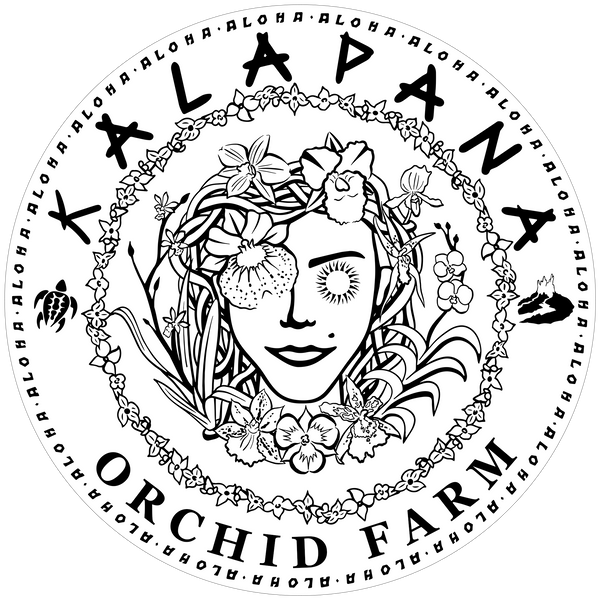Kalapana Orchid Farm
Miltassia Royal Robe
Miltassia Royal Robe
Couldn't load pickup availability
When we talk about Mtssa. Royal Robe, we're stepping into the captivating world of Oncidium alliance hybrids, specifically one that now goes by the accepted name Bratonia Royal Robe. This particular grex is a cross between Bratonia Erachne and Miltonia Seminole Blood, registered by Everglades in 1986.
Let's delve into its family tree to understand its unique characteristics. The "Mtssa." or "Bratonia" designation indicates a hybrid between Brassia and Miltonia.
Bratonia Erachne: This is a hybrid of Brassia arcuigera and Miltonia spectabilis.
Brassia arcuigera: Commonly known as the "spider orchid" due to its long, narrow sepals and petals, this species is native to Ecuador, found at elevations of 3,300 to 5,000 ft. It grows as an epiphyte in humid cloud forests, experiencing intermediate to warm temperatures.
Miltonia spectabilis: Hailing from Brazil, this is a warm-growing Miltonia species, often found as an epiphyte in seasonally dry to wet forests at lower elevations. It's known for its relatively large, often solitary flowers.
Miltonia Seminole Blood: This hybrid traces its lineage back to Miltonia clowesii and Miltonia russelliana, both warm-growing Miltonia species from Brazil.
So, Mtssa. Royal Robe is a truly complex hybrid, drawing from both the spider-like allure of Brassia and the elegant, often broad-lipped nature of Miltonia. The influence of Brassia arcuigera is particularly strong, often dictating the starry, elongated flower shape.
This orchid typically develops prominent, ovoid to somewhat compressed pseudobulbs, reaching 2 to 3 inches tall, topped with 1 to 2 strap-like, light yellowish-green leaves that are 8 to 15 inches long and 1 to 2 inches wide. The overall plant height can be around 12 to 18 inches.
Now, for the stunning part: the flowers! Mtssa. Royal Robe produces upright to arching inflorescences, often bearing 3 to 6 or more flowers that are truly impressive in size, typically reaching 4 to 6 inches from tip to tip. The sepals and petals are usually elongated and tapering, displaying a captivating base color of rich burgundy, deep red, or a velvety chocolate brown, often with a subtle green or bronze cast, especially towards the tips. The lip is a true marvel, broad and often marked with intricate patterns, frequently featuring a contrasting white or pinkish-white background heavily overlaid with radiating veins and blotches of the same rich red or burgundy as the other segments. Many find a delightful, light fragrance, sometimes described as raspberry or chocolate, particularly prominent in the mornings. This hybrid is known for its long-lasting blooms and its ability to flower multiple times a year under good culture.
Care Instructions:
Light: Provide bright, indirect light. A good indicator is if the leaves are a light yellowish-green; darker green foliage often indicates insufficient light, which can inhibit flowering. Some direct morning sun or dappled light is beneficial, but protect from harsh midday sun to prevent leaf burn.
Water: Keep the potting medium consistently moist during active growth, allowing the top layer to just approach dryness before watering thoroughly. Avoid allowing the plant to sit in stagnant water. Reduce watering slightly during cooler, less active periods. Rainwater or demineralized water is preferred due to sensitivity to mineral salts.
Temperature: This hybrid is quite adaptable and tolerant of a range, generally preferring intermediate to warm conditions. Daytime temperatures should be between 70 to 85°F, with a night temperature drop to 55 to 65°F. It can tolerate cooler nights down to 50°F and warmer days if humidity is maintained.
Humidity: Maintain high humidity levels, ideally between 50% and 70%. In drier environments, consider using a humidity tray or a humidifier. Good air circulation is crucial to prevent fungal issues and ensure healthy root development.
Potting Medium: Use a well-draining, coarse orchid mix that allows for good air circulation around the roots. A blend of fir bark, perlite, and charcoal, or sphagnum moss, works well. Repot when new root growth emerges, typically every 1 to 2 years, or when the medium breaks down.
Fertilizer: Fertilize regularly during active growth with a balanced orchid fertilizer diluted to half or quarter strength, approximately every two weeks. Reduce feeding to once a month or cease entirely during the winter or less active growth phases. Flush the pot with plain water monthly to prevent fertilizer salt buildup.
These are full, beautiful plants, many with multi-spikes, grown in 4" pots.
Share






